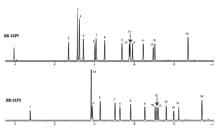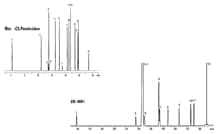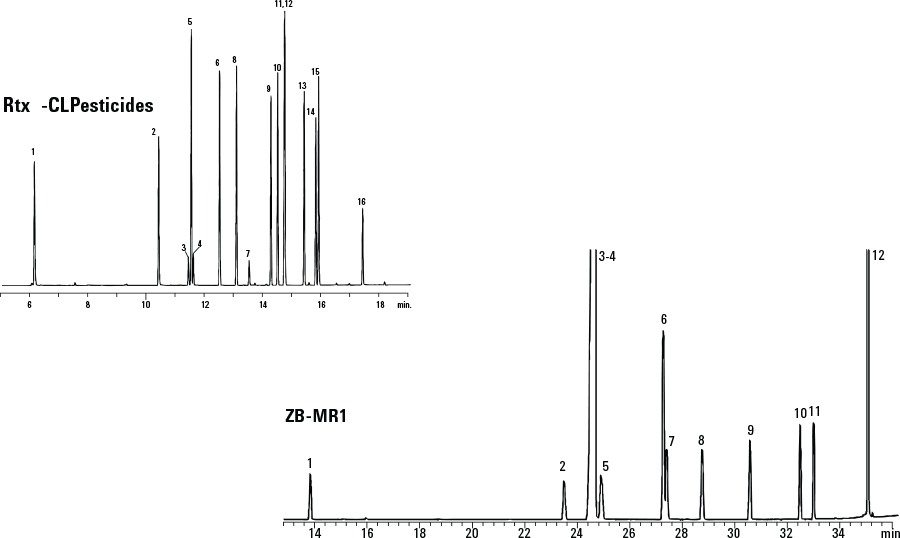Access Agilent eNewsletter, January 2015
>> Update My Profile | Subscribe to Access Agilent | Article Directory

Selectively and quickly separate halogenated compounds without co-elution using
Agilent J&W GC columns
By Gary Lee
Product Marketing Manager, Agilent J&W GC columns
In the following article we will show how pairs of Agilent J&W GC columns selectively separate halogenated compounds using EPA Method 504.1 and 505 – in a much faster manner and without co-elution. This is the next installment from our four-part GC column excellence tips and techniques series examining how to get the best results possible in all of your GC lab work.
Faster oven cool down and higher throughput with Agilent columns
Agilent J&W DB-CLP1 and DB-CLP2 columns are the most flexible and universal column pair for nine EPA dual-ECD pesticide methods. Together, these fast, reliable columns deliver excellent resolving power with exceptionally low bleed. In the example below, we describe the analysis of the halogens 1,2-dibromoethane (EDB),1,2-dibromo-3-chloropropane (DBCP), and 1,2,3-trichloropropane (123TCP). The DB-CLP1 and DB-CLP2 column pair resolved 12 of these analytes in less than six minutes (Figure 1A), compared to seven analytes with the Restek column (Figure 1B). Faster oven cool down with the Agilent columns also decreases GC cycle time, for higher throughput.
 Enlarge
Enlarge
Figure 1. The Agilent J&W DB-CLP1 and DB-CLP2 column set separates 12 EPA Method 504.1 halogenated compounds in under six minutes (A) compared to only seven analytes on the Restek column pair (B).
 Enlarge
Enlarge
Figure 2. The Agilent J&W DB-CLP1 and DB-CLP2 column set separates 16 EPA Method 505 organohalide pesticides in under 14 minutes.
 Enlarge
Enlarge
Figure 3. Analysis of organohalide pesticides on primary Restek and Phenomenex columns.
No co-elutions on primary column with Agilent environmental solutions
EPA Method 505 deals with the analysis of organohalide pesticides. In the example shown in Figure 2, Agilent J&W DB-CLP1 and DB-CLP2 columns resolved 16 organohalides in less than 14 minutes, faster than the Phenomenex and Restek column pairs, which took 35 minutes and 18 minutes, respectively In addition, the Agilent set delivered the added benefit of no co-elutions on the primary column (Figure 3).
More work, less time with Agilent columns
To recap, by using Agilent J&W DB-CLP1 and DB-CLP2 GC column pairs, you can do more work in less time, without the need for extra resources. In previous articles from this series, we showed you how to avoid the need for rework and boost your lab’s productivity by choosing Agilent J&W Ultra Inert GC columns, with exceptional low bleed and inertness.
Another way of improving productivity is to use columns in pairs, which means you avoid having to switch between column sets for different methods, and can easily move methods over if an instrument goes down.
Next month, in the final article of the series, we will explain how you can reduce column bleed – another source of baseline noise and interference that can lead to questionable results and the need for rework. Until then, see for yourself how Agilent J&W GC columns lead the market for versatility and inertness.
>> Update My Profile | Subscribe to Access Agilent | Article Directory
Figure 1.

Peak ID, Figure 1A
- Chloroform
- 1,1,1-Trichloroethane
- Carbon tetrachloride
- Trichloroethene
- Bromodichloromethane
- Tetrachloroethene
- 1,1,2-Trichloroethane
- Dibromochloromethane
- 1,2-Dibromoethane (EDB)
- Bromoform
- 1,2,3-Trichloropropane (123TCP)
- 1,2-Dibromo-3-chloropropane (DBCP)
Peak ID, Figure 1B
- Bromodichloromethane
- Chlorodichloromethane
- 1,2-Dibromoethane (EDB)
- 1,1,2-Trichloroethane
- Bromoform
- 1,2,3-Trichloropropane (123TCP)
- 1,2-Dibromo-3-chloropropane (DBCP)
The Agilent J&W DB-CLP1 and DB-CLP2 column set separates 12 EPA Method 504.1 halogenated compounds in under six minutes (A) compared to only seven analytes on the Restek column pair (B).
Figure 2.

Peak ID
- Hexachlorocyclopentadiene
- Hexachlorobenzene
- Atrazine (25 µg/mL)
- Simazine (25 µg/mL)
- γ-BHC
- Heptachlor
- Alachlor (1 µg/mL)
- Aldrin
- Heptachlor epoxide
- γ-Chlordane
- trans-Nonachlor
- α-Chlordane
- Dieldrin
- Endrin
- cis-Nonachlor
- Methoxychlor (0.5 µg/mL)
The Agilent J&W DB-CLP1 and DB-CLP2 column set separates 16 EPA Method 505 organohalide pesticides in under 14 minutes.
Figure 3.

Peak ID
- Hexachlorocyclopentadiene
- Hexachlorobenzene
- Atrazine (25 µg/mL)
- Simazine (25 µg/mL)
- γ-BHC
- Heptachlor
- Alachlor (1 µg/mL)
- Aldrin
- Heptachlor epoxide
- γ-Chlordane
- trans-Nonachlor
- α-Chlordane
- Dieldrin
- Endrin
- cis-Nonachlor
- Methoxychlor (0.5 µg/mL)
Analysis of organohalide pesticides on primary Restek and Phenomenex columns.